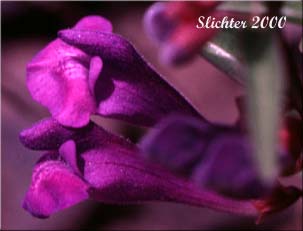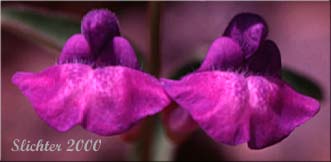 Narrow-leaf
skullcap from Doug's Beach, Columbia River Gorge......April 28, 1998. Note the
large lower lip and prominent nose-like appearance of the upper lip.
Narrow-leaf
skullcap from Doug's Beach, Columbia River Gorge......April 28, 1998. Note the
large lower lip and prominent nose-like appearance of the upper lip.
Skullcaps get their name from a small appendage or flap atop the calyx. Narrow-leaf skullcap is an attractive perennial arising to heights of 10-30 cm from rhizomes. The slender, erect stems may be branched or arise in clusters from the rhizome. The stems are square in cross-section. The herbage is variably haired, ranging from glabrous to short, upward-pointing hairs, or occasionally longer, spreading or even gland-tipped hairs. The leaves are opposite with entire margins. All the leaves are found on the stems. The venation consists of 3-5 nerves or veins arising from the leaf base. Leaf shape is elliptic to ovate, and the leaves range from 1.5- 2.5 cm long and 3-10 mm wide.
The flowers are solitary, arising from the axils of the upper, reduced leaves. The corolla is a deep blue-violet. The tubular corolla ranges from 24-28 mm long and expands gradually to the widened mouth. The lower lip of the corolla is large, and reflexed downward.. The palate has long white hairs.
Narrow-leaf skullcap may be found on rocky, graveled or talus slopes with dry exposures.
Narrow-leaf skullcap may be found east of the Cascades from southern British Columbia south through Washington and Oregon to California. It may be found eastward to western and northern Idaho. It may occasionally be found in the Willamette Valley.
In the Columbia River Gorge, it may be found between the elevations of 100'-1300' from about Dog Mt. east to approximately adjacent to Celilo, OR..
Narrow-leaf skullcap may be planted in the home rock garden, but it should be give room, or enclosed within grass edging plastic as the rhizomes have a tendency to travel, usually where a much preferred plant, like a Lewisia is growing. With time, it may overgrow or crowd out other plants, so it should be kept in check. I pull the rhizomes and stems and replant them in desired areas. The rhizomes re-root readily. The flowers and stems have a noticeable, sharp, minty scent.
